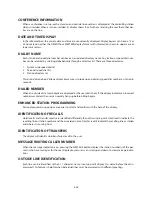
Class of Service act as one station. This is convenient when an individual has two offices or an office exten-
sion and a cordless extension. NOTE: Not all system features are applicable to station pairs. Features designed
for a single user may conflict with paired stations.
SYSTEM ALARMS
A DISA alarm will warn the customer if the DISA security system has been triggered by too many incorrect
password attempts. The alarm can ring any station or group of stations and show an appropriate display at
the assigned stations.
SYSTEM MAINTENANCE ALARMS
The OfficeServ 7200 continuously performs internal system diagnostics. When either a major or minor fault
is detected the system can ring stations with an ALARM KEY assigned. The keyset display shows information
that includes the description, location and date and time stamp for each alarm.
A log of 100 alarms are stored in a buffer and can be reviewed at a display keyset or sent to a printer.
SYSTEM DIRECTORY
Each station, station group and outside line can have an 11 character directory name. This name will appear
on keyset displays to provide additional information about lines and stations.
TENANT SERVICE (2)
The OfficeServ 7200 supports two forms of tenant service as detailed below.
•
System Splitting: In the first form there are several programs that allow the OfficeServ 7200 to be
installed in tenant applications. These features allow a technician to split the system in two with each
tenant having individual control over operator groups, page zones, speed dial numbers, night service
(manual or automatic), DISA and customer level programming. Each tenant is totally separate in the sys-
tem and no intercom calling between tenants is permitted.
•
Port Splitting: In this form of tenant services system programming is used to allow or deny access for
making and receiving calls on a per station basis. These settings can be applied to Trunks, trunk groups,
stations and station groups. This allows common items on the system such as the operator group and
LCR to be used by everyone on the system while ensuring that each company can only access their own
lines and incoming calls.
TOLL RESTRICTION
There are 500 allow and 500 deny entries of 11 digits each. Each of these entries can apply to dialing classes
B, C, D , E, F and G. Expensive 976, 1-900, 411 and operator-assisted calls, as well as specific area and office
codes, can be allowed or denied on a per-class basis. Class A stations have no dialing restrictions and Class H
stations cannot make outside calls. Any outside line may be programmed to follow station toll restriction or
follow the toll restriction class assigned to it. Each station and trunk can have a different dialing class for each
ring plan.
Special Code Table
A Special Code Table of ten entries (four digits each) allows use of telephone company features such as CID
blocking (*67) or call waiting disable (*70) without interference to toll restriction or LCR. The Special Code
table allows use of these custom calling features on a per call basis.
4.26
















































